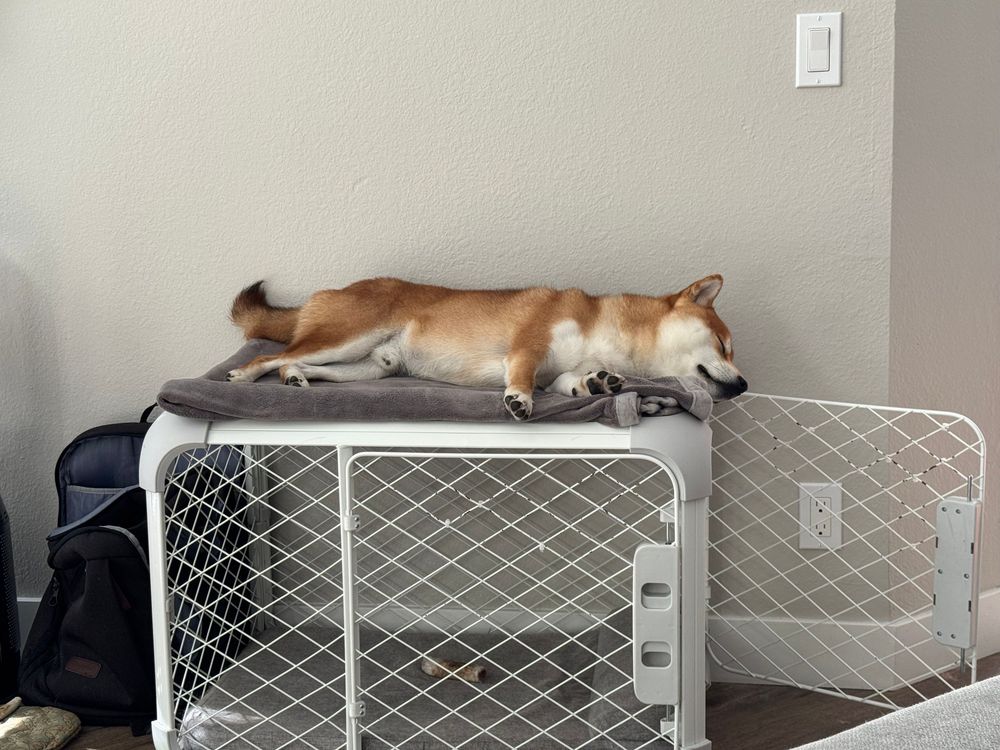
How Crate Training Creates a Safer, Happier Home for Your Dog
Note: The picture above is a bit misleading as crate training is about helping your dog feel comfortable inside the crate, not on top of it. Creed prefers to nap on top of the crate instead of inside I guess.
Crate training is often misunderstood as a form of punishment or confinement, but in reality, it's a powerful tool for creating a safer, more organized home environment for both pets and their owners. By providing a secure space for your dog to relax, sleep, and feel protected, crate training can help with housebreaking, reduce separation anxiety, and even prevent destructive behavior when you're not around. Let's dive into the benefits of crate training and how to implement it effectively.
What is Crate Training?
Crate training involves using a crate or enclosure to provide your dog with a designated area where they can feel safe and secure. This space becomes their own personal sanctuary, helping them relax and reduce stress. The crate should be large enough for your dog to stand up, turn around, and lie down comfortably.
Benefits of Crate Training
Crate training offers numerous benefits for both dogs and their owners:
Housebreaking Assistance
Crate training is invaluable for housebreaking. Dogs naturally avoid soiling their sleeping areas, so by confining them to a crate when you're not supervising, you can reduce accidents in the house. This method helps establish a routine and teaches your dog to hold their bladder until they're taken outside.
Reduced Separation Anxiety
Dogs often suffer from separation anxiety when left alone, leading to destructive behavior or excessive barking. A crate provides a sense of security and comfort, helping to alleviate these feelings of anxiety. It acts as a cozy den where your dog can retreat when feeling overwhelmed.
Prevention of Destructive Behavior
When you're not home, your dog might engage in unwanted behaviors like chewing furniture or digging. By keeping them in a crate, you can prevent these destructive habits and protect your belongings.
Safety and Protection
Crates are especially useful for puppies or new dogs in the home. They prevent access to hazardous items like electrical cords or toxic substances, keeping your pet safe from harm.
Travel and Portability
Crates are also beneficial for travel. They provide a familiar space for your dog during car rides or stays in new environments, reducing stress and anxiety.
How to Crate Train Your Dog
Implementing crate training requires patience and consistency. Here's a step-by-step guide:
Introduce the Crate Gradually
- Start by leaving the crate door open and placing treats or toys inside to entice your dog to enter voluntarily.
- Once your dog is comfortable entering the crate, begin closing the door while you're still in the room.
Increase Crate Time
- Gradually increase the time your dog spends in the crate while you're in the same room.
- As they become more comfortable, you can start leaving the room for short periods.
Establish a Routine
- Use the crate consistently, such as during meals or when you're not home.
- Make sure your dog has plenty of exercise and playtime outside of the crate to prevent boredom and frustration.
Avoid Overuse
- Don't use the crate as a form of punishment or leave your dog in it for extended periods. This can lead to negative associations and stress.
Choosing the Right Crate
Selecting the right crate for your dog is important:
Size: Ensure the crate is large enough for your dog to stand up, turn around, and lie down comfortably.
Material: Choose durable materials that can withstand chewing or scratching.
Ventilation: Opt for crates with good ventilation to keep your dog cool and comfortable.
Crate training is a valuable tool for pet owners, offering a range of benefits from housebreaking assistance to reducing separation anxiety. By introducing the crate gradually and using it consistently, you can create a safer, more organized home environment for both you and your dog. Remember, patience and consistency are key to successful crate training. With time and practice, your dog will learn to love their crate as a cozy retreat, and you'll enjoy the peace of mind that comes with knowing your home is protected and your pet is happy.